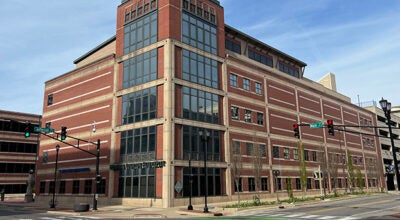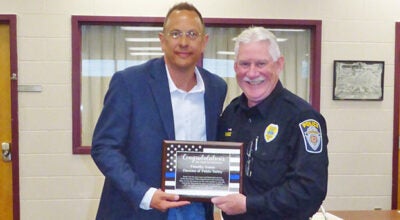Every day a gift for survivor of a double lung transplant
Published 8:56 am Monday, April 26, 2010
By JOHN EBY
Dowagiac Daily News
CASSOPOLIS – Edwin A. “Al” Miller Jr. was born in St. Louis and became a “huge Cardinals fan” listening to Harry Caray and Jack Buck. His team lost the 1968 World Series to the Detroit Tigers.
Miller would return to his hometown from Elgin, Ill., in 2006 to meet the family of Damien Blackmon, whose lungs had been transplanted into his chest.
In fact, the meeting took place at Mid-American Transplant Services, where the 25-year-old man’s organs had been harvested after Thanksgiving 2004 and gave new life to eight people.
Damien’s mother Mary told the Millers her son died in a drive-by shooting.
He wasn’t a gang member, but a young woman riding in the same car had witnessed a gang slaying a week before.
“In an attempt to tidy things up, they were going to take her out,” Al said. “They riddled the car with bullets,” killing her, the driver and hitting Damien in the leg and head.
“He got out and walked about 150 yards in the bad part of St. Louis until he collapsed on a porch.”
In transplant parlance, Mid-American Transplant Services is an OPO, or organ procurement organization. In Illinois, its called the Gift of Hope; in Michigan, the Gift of Life.
“They have the thankless job of approaching a family who has just experienced a tragedy” and inquire about their willingness “to let your loved one live on.”
Dave, tasked with approaching Mary, initially met resistance, but finally she relented.
Damien’s skin, corneas, lungs, liver, heart, kidneys were harvested.
“I’ll never forget the first time we met her,” Al said. “All my towhead kids. She walks in and says, ‘You’re all so white.’ All of us wept for like 20 minutes.”
Mary “just wanted to put her head on my chest and listen to me breathe. It was very humbling. Here we were with my family taking a vacation. My wife had just put together a one-year anniversary DVD. And all she had was a picture of Damien when he was 12. We were humbled by what she didn’t have.”
Now Mary goes with Dave to the hospital to talk with other families.
She takes with her a copy of Al’s letter.
The original is framed on her apartment wall.
Al remembers the agonizing wait before the double lung transplant saved his life:
“As you stand on the edge and look into the pit, you think, ‘Boy, the priorities of my life were messed up. Suddenly, things which were important aren’t anymore. People and relationships are important. It’s funny how it takes something like that to get you to that place. Every birthday, every holiday, might be the last,” he recalled Saturday evening at St. Paul Lutheran Church, where his brother-in-law is congregation president.
“Every single day is a gift,” Miller said.
The daughter he lived to walk down the aisle has given him two grandchildren.
Miller, who attended Valparaiso University for three years and continued playing football, is Cass County Prosecutor Victor Fitz’s brother-in-law.
They met in 1975 when Al’s wife, Mary, was a senior and Fitz was a “bright-eyed freshman.”
Miller married Fitz’s sister in 1978.
“We did our part to replenish the earth. We have seven kids,” three sons and four daughters.
More than 15 years ago when he was about 40, Al was out of shape and thought it was time to take off the spare tire accumulated since college.
“It’s really not a battle of the bulge,” he joked, “because I’m in full retreat.”
As he tried to get back into shape, he became winded easily. That troubled him since he ran four to five miles a day in college to stay in shape.
He underwent a full physical, then left for a family camping vacation at Wilderness State Park near Mackinac.
“When we got back,” he recalls, “there were several messages on our answering machine from my doctor he needed to see me right away.”
Following more tests, Miller found himself diagnosed with a rare lung disease, sarcoidosis, which causes inflammation and, eventually, scarring and loss of function. It has no known cause and, worse, no known cure.
In 95 to 97 percent of people with this disease, treatment with corticosteroids, such as Prednisone, clears it up without experiencing any recurrence.
“I was in that 3 percent to 5 percent group where the disease is chronic and, eventually, fatal,” Miller said. “I felt fine and looked fine, but pulmonary function testing revealed my lungs were not fine.”
He felt fortunate that through a friend who put in a pool for a doctor, he came under the care of another doctor with a great pulmonary program at Loyola University, where they could monitor the disease’s progress and address his symptoms over years.
By 2000, the disease had progressed to such a point the Millers could no longer enjoy camping because of the danger of catching a cold or respiratory infection.
Worse yet, it was getting to the point where he couldn’t do much of anything that required any physical exertion. Al couldn’t mow his lawn or work around the house.
“I couldn’t make even the simplest repairs to my home. Some guys might say, ‘What’s wrong with that?’ but having always been sort of a self-made, independent guy, the depression and emotional struggles with not being a ‘man,’ but almost an eighth ‘child’ for my wife to look after seemed, at times, worse than the physical maladies I was facing. Life wasn’t much fun anymore.”
About this same time, Miller’s mother was diagnosed with pulmonary fibrosis.
For the next three years he watched her struggle and eventually lose her battle with this disease.
She was only 68 when she died in September 2003.
“The loss of a loved one is always hard,” he says, “but what was really difficult was to know that I was headed to a very similar struggle toward death unless something was to change. It was also about this time, just prior to my mother’s death, my doctor said he was going to put me on the list as a candidate for lung transplantation. He told me that based on my test numbers and his experience I had 1 1/2 to two years to live without a transplant and it usually takes, on the average, that same time to get a donor.”
“The news was bittersweet,” Miller said. “I was excited about the hope of possibly continuing my life, but scared that I was dying – and very soon.”
As the disease progressed, Miller’s life became more difficult and fraught with danger.
The smallest cold could hospitalize him for a week.
That happened twice.
“I started to use oxygen at home when I slept at night and eventually 24 hours a day, both at home and at work,” where Miller was an operations manager for a commercial heating and air conditioning company.
His responsibilities include oversight of the engineering and project management departments, and all of the computer systems.
“Fortunately,” he says, “I ‘drive a desk’ for a living, but even getting from my car, across the parking lot and to my desk became a daily challenge. Life was hard, but my faith in Christ reminded me that to be with Him was a great reward, but to remain would be better for those who needed me.”
Around the house he wore a “100-foot leash” of oxygen. “If my wife wanted to get ahold of me, she’d just pull on it,” he said. “We had an oxygen storage tank in the garage and I’d have to go out there and pump up my fanny pack with liquid oxygen to go to work.”
Miller wore a pager 24 hours a day, which only the hospital knew the number, to call him in the event a donor became available.
“But that idea, the concept of a ‘donor,’ seemed so detached, so cold, so impersonal – the real-life fact that some ONE, not something, would have to die in order for me to live, became so hard to imagine, to get our arms around, so my wife, kids, family and friends became to pray” for the donor family they were yet to meet.
“We prayed that God would begin to prepare your hearts for the coming tragedy and loss and that He would be your very real comfort.”
As time passed, the Millers made a will and planned a funeral service, just in case.
On Nov. 28, 2004, at 4:23 a.m. just after Thanksgiving, Mary was awakened by the ringing of their home phone. She was not able to get to the phone in time, but just about then, his cell phone began ringing.
She answered. It was the hospital calling to say a potential donor had been found and they should get there as soon as possible.
Transplant program coordinators told them sometimes donated lungs might not be suitable, so they left for the hospital “hoping, but holding on loosely to whatever was in store for us,” Miller recalls. “You say your goodbyes because you don’t know what God has in store. It’s a major operation.”
Al heard about one fellow who got called in five times before the organ was viable.
“I went into surgery around 11 a.m. The transplant procedure took over 10 1/2 hours for both lungs. I was in recovery for about eight hours. The lead doctor later told my family and friends that my old lungs were so badly deteriorated and scarred, they resembled concrete or gravel, and actually the upper lobes of my left lung needed to be ‘chiseled’ out” of his chest cavity.
Nurses said his new lungs “were perfect – pink and fluffy and beautiful.” He would learn that the donor’s mother prayed for him as well.
“In a bilateral lung transplant, they do what they call a clam section. They cut you from here, underneath this breast, across your sternum and underneath this breast – a 24-inch incision, like opening up a lobster. One of the technicians had a cool way of referring to it,” Miller said. “He said, ‘They cut you from side to side, then they pop the hood.’ It took longer because my lung was like scraping out wet cardboard. I remember waking up and the first thing you think is, ‘I’m alive,’ though you can’t move because they’ve got you Velcroed down, with a 12-inch respirator down your throat.’ ”
Released from the hospital in just five days, Miller endured a “steady and sure” recovery despite “a few bumps along the way,” including infection, collapsed lungs from fluid buildup and being weaned off his Vicodin addiction for excruciating pain.
He takes anti-rejection drugs which suppress his immune system and others to offset those.
In fact, 12 to 14 medications daily.
As he wrote to the Blackmon family that August, “I returned to work the first week in February 2005. Whereas before I couldn’t climb a single flight of stairs with oxygen without gasping for breath, I now can go up four to five flights on different construction sites without ever stopping. I can watch my 16-year-old son, Lucas, play his baseball games, standing behind the backstop, instead of sitting in the car because I need the air conditioning.
“I mowed the lawn a couple of weeks ago for the first time in eight years. I rototilled the flower garden yesterday so my wife could plant some day lilies. Perhaps the most exciting thing is I walked my 20-year-old daughter, Lauren, down the aisle on May 7 to marry a very good man, when almost six months ago, I didn’t even think I would be here for the wedding. And to everyone’s embarrassment except mine, I made a complete fool of myself by dancing almost every dance at the reception … and none of this would have been possible without the gift you and your loved one gave me.
“I can’t ever thank you enough!” he wrote to Mary, apologizing that “words are a very poor, almost trivial, way to express what I want to say and feel for you … I want you to know that your loss was not in vain. Your loss has brought joy and happiness to dozens, even hundreds, of my family members and friends who would want to thank you as well.
“I got my life back because you were willing to let your loved one live on in my life. I truly, truly hope (if you’re willing of course) to meet you face to face and thank you in that way. I know that may be difficult for you, and I don’t want you to feel any pressure, but my family and I would love to meet you and thank you in person. Whatever you decide, please know that I think of you every day, with every breath I take. I’m alive because of your gift!”
He said major religions support organ transplant because “this is just a vessel, it’s not who we are.”






